Birdfinding.info ⇒ Common and widespread throughout Cuba, where it can be found at most, if not all, of the principal birdwatching sites, and in some urban parks, such as the National Botanical Garden in Havana. Usually easy to find at Península de Guanahacabibes National Park, anywhere in the western mountains (Viñales and La Güira National Parks and the Sierra del Rosario), throughout the Zapata Swamp area, at Rancho La Belén, and on Cayo Coco, among other places. (For the Bahaman form, see “Bahama Lizard-Cuckoo”.)
Great Lizard-Cuckoo
Coccyzus merlini
Endemic to Cuba, its satellites, and the central Bahamas. Inhabits various types of wooded and semiopen habitats.
Two distinct forms are recognized, and in some cases treated as separate species:
“Cuban Lizard-Cuckoo”: Cuba, the Isle of Youth, and many smaller adjacent islands.
“Bahama Lizard-Cuckoo”: Andros and Eleuthera; extirpated from New Providence.
Identification
A large, lanky, long-tailed, cuckoo, with striking scarlet orbital skin, brown upperparts, pale throat and breast, rusty or buffy belly and vent, and rufous patches on the primaries.

“Cuban Lizard-Cuckoo,” C. m. merlini. (Pinar del Río, Cuba; November 27, 2014.) © Dubi Shapiro
The undertail has a black-and-white pattern that resembles that of several other Coccyzus cuckoos.

“Cuban Lizard-Cuckoo,” C. m. merlini. (Pinar del Río, Cuba; November 9, 2017.) © Allen Lewis

“Cuban Lizard-Cuckoo,” C. m. merlini. (Los Sabalos, Matanzas, Cuba; February 13, 2016.) © Colin D. Jones

“Cuban Lizard-Cuckoo,” C. m. santamariae. (Cayo Coco, Cuba; March 3, 2019.) © Dave Curtis

“Cuban Lizard-Cuckoo,” C. m. merlini. (Viñales, Pinar del Río, Cuba; November 10, 2018.) © Michael J. Good

“Cuban Lizard-Cuckoo,” C. m. merlini, drying its waterlogged feathers and showing its less impressive underlying size. (Soplillar, Matanzas, Cuba; May 25, 2018.) © Adriana Dinu
“Cuban Lizard-Cuckoo” varies widely in the overall tone of its plumage, especially the upperparts, which are typically a neutral or warm shade of brown, but can be anywhere on a spectrum from dull grayish to bright rufous.
Its throat and breast vary from whitish to ashy-gray to buffy to cinnamon, and its belly and vent vary from cinnamon to rufous.
The mainland subspecies, merlini, encompasses most, if not all, of the variability in plumage tone, but tends to fall in the middle or the warmer, brighter, redder of the spectrum.
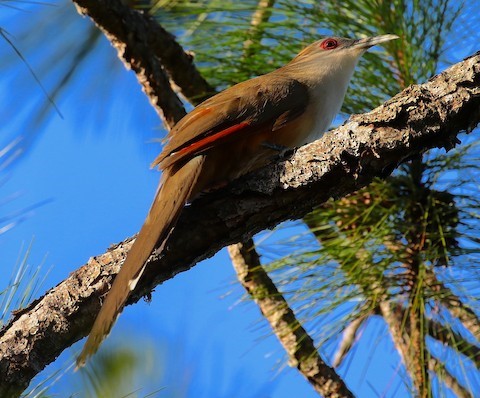
“Cuban Lizard-Cuckoo,” C. m. merlini, showing warm-brown upperparts typical of this widespread subspecies. (Sendero La Ermita, Pinar del Río, Cuba; February 21, 2018.) © Arco Huang

“Cuban Lizard-Cuckoo,” C. m. merlini, showing neutral-brown upperparts. (Playa Pesquero, Holguín, Cuba; March 14, 2019.) © Diane St.-Jacques
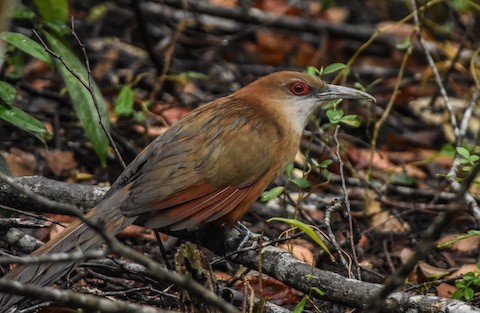
“Cuban Lizard-Cuckoo,” C. m. merlini, showing warm-brown upperparts with bright rusty highlights. (Playa Larga, Matanzas, Cuba; April 21, 2017.) © Daniele Mitchell
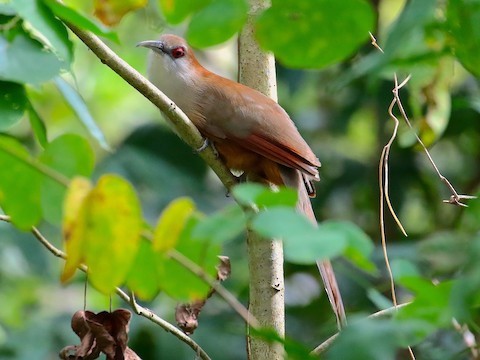
“Cuban Lizard-Cuckoo,” C. m. merlini, showing warm-brown upperparts with rusty highlights. (Cueva de los Portales, Pinar del Río, Cuba; February 22, 2018.) © Arco Huang
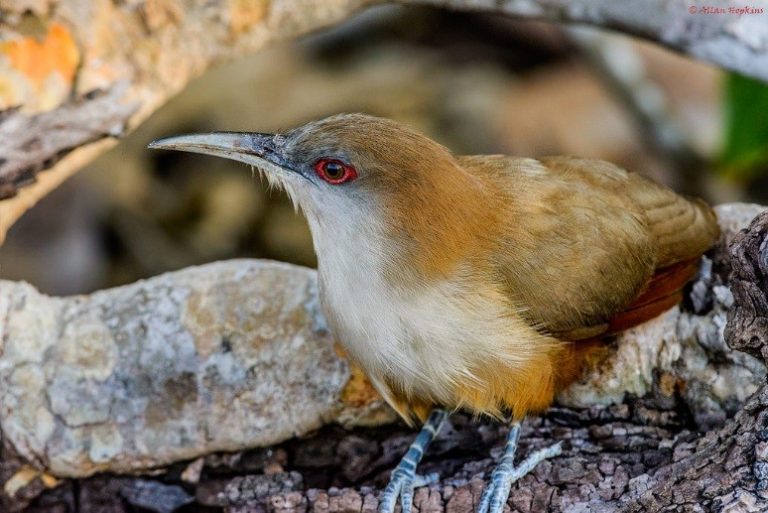
“Cuban Lizard-Cuckoo,” C. m. merlini, showing warm-brown upperparts with rusty highlights. (Playa Larga, Matanzas, Cuba; April 13, 2015.) © Allan Hopkins
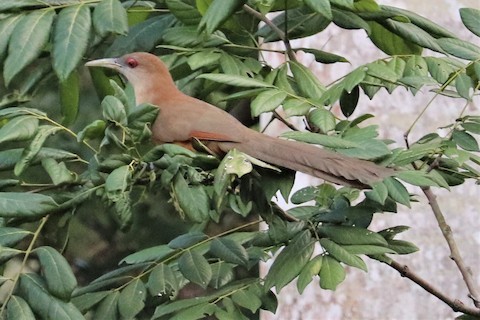
“Cuban Lizard-Cuckoo,” C. m. merlini, showing warm-brown upperparts with rusty highlights. (Sendero de las Aves, Camagüey, Cuba; January 14, 2019.) © Gail DeLalla
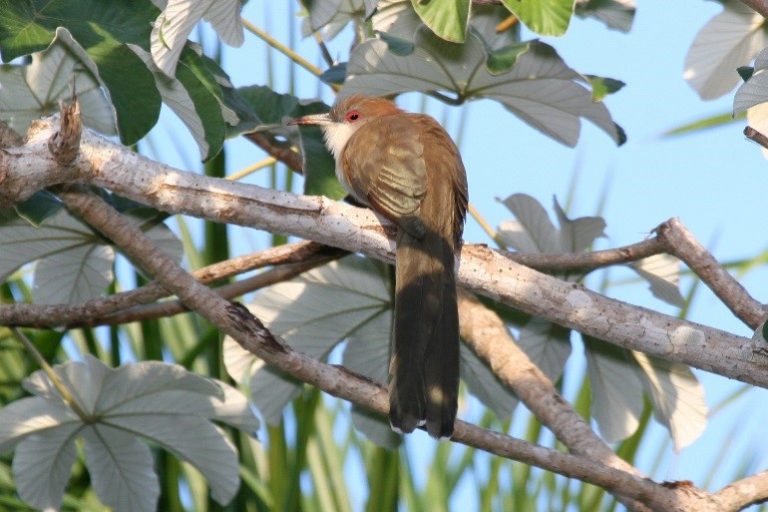
“Cuban Lizard-Cuckoo,” C. m. merlini, showing warm-brown upperparts. (November 9, 2006.) © Dominic Sherony
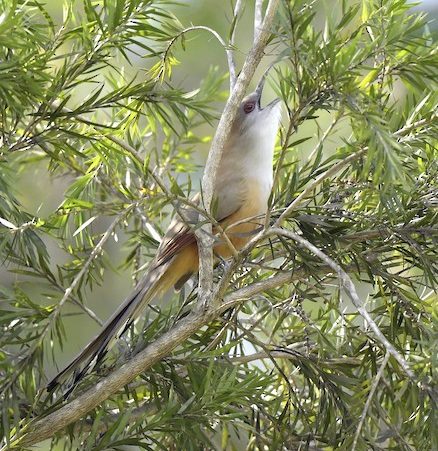
“Cuban Lizard-Cuckoo,” C. m. merlini, showing grayish upperparts, somewhat atypical of this subspecies. (Cienfuegos Botanical Garden, Cienfuegos, Cuba; February 25, 2019.) © Paul Arneson
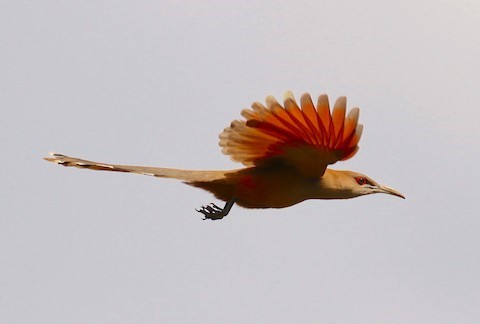
“Cuban Lizard-Cuckoo,” C. m. merlini, showing bright rufous wings. (Bermejas Wildlife Refuge, Matanzas, Cuba; February 23, 2018.) © Arco Huang
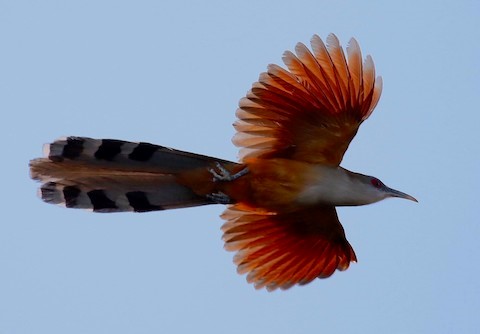
“Cuban Lizard-Cuckoo,” C. m. merlini, showing bright rufous wings and belly. (Sendero La Ermita, Pinar del Río, Cuba; February 21, 2018.) © Arco Huang

“Cuban Lizard-Cuckoo,” C. m. merlini, fully fanned-out in flight, showing bright rufous wings. (Cienfuegos Botanical Garden, Cienfuegos, Cuba; February 18, 2018.) © Linette Mansberger

“Cuban Lizard-Cuckoo,” C. m. merlini, showing exceptionally rufous plumage. (Soplillar, Matanzas, Cuba; July 10, 2017.) © Erika Gates
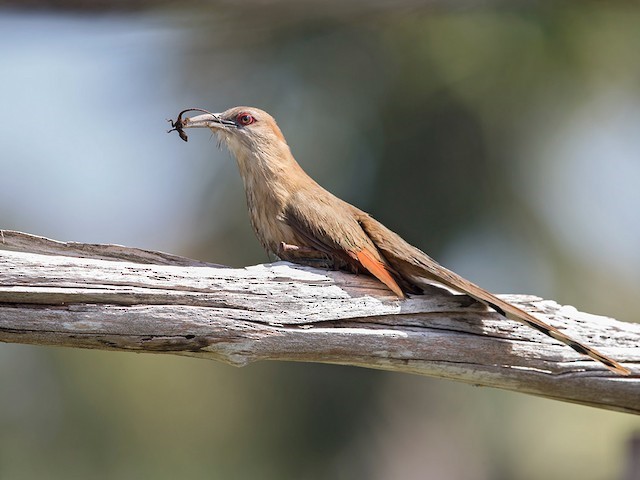
“Cuban Lizard-Cuckoo,” C. m. merlini, showing neutral-brown upperparts, holding its signature prey. (Soplillar, Matanzas, Cuba; February 1, 2016.) © Dave Williams

“Cuban Lizard-Cuckoo,” C. m. merlini, close-up of the previous bird and its snack. (Soplillar, Matanzas, Cuba; February 1, 2016.) © Dave Williams

“Cuban Lizard-Cuckoo,” C. m. santamariae, impersonating a roadrunner. (Cayo Coco, Cuba; March 22, 2017.) © Alan Wells
The two insular Cuban subspecies, santamariae (Jardines del Rey Archipelago) and decolor (Isle of Youth) seem mostly limited to the plainer, grayer end of the spectrum.
“Bahama Lizard-Cuckoo” (covered separately) resembles the insular Cuban subspecies, but is typically even plainer and grayer.
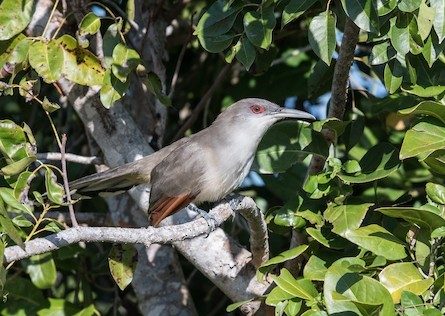
“Cuban Lizard-Cuckoo,” C. m. santamariae, showing the mostly grayish upperparts typical of this subspecies. (Cayo Coco, Cuba; February 3, 2019.) © Simon Boivin
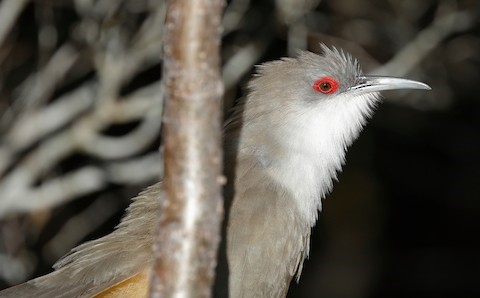
“Cuban Lizard-Cuckoo,” C. m. santamariae, showing the mostly grayish upperparts typical of this subspecies. (Cayo Coco, Cuba; March 9, 2017.) © Timo Mitzen

“Cuban Lizard-Cuckoo,” C. m. santamariae, showing neutral-brown upperparts. (Cayo Coco, Cuba; May 3, 2013.) © William Price
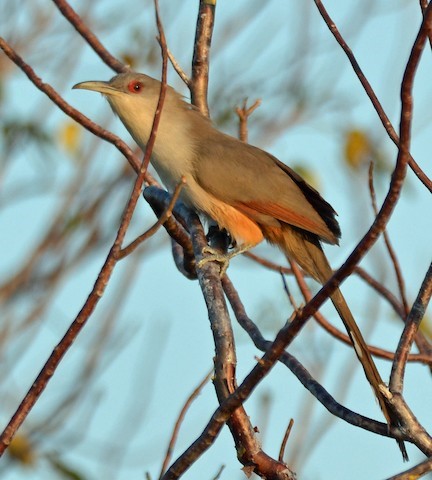
“Cuban Lizard-Cuckoo,” C. m. santamariae, showing the mostly grayish upperparts typical of this subspecies. (Cueva de Jabalí, Cayo Coco, Cuba; April 9, 2018.) © Michael J. Good
Immatures closely resemble adults but their orbital skin is more dull yellow or orange than red.
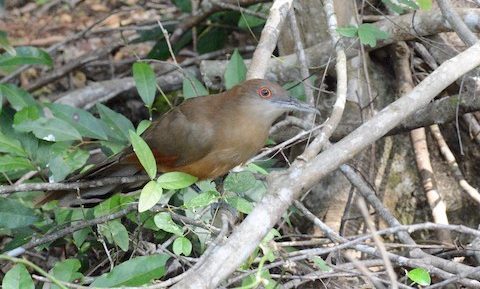
“Cuban Lizard-Cuckoo,” C. m. merlini, immature, showing unusually dark throat and breast. (Soplillar, Matanzas, Cuba; January 29, 2016.) © Aaron Marshall

“Cuban Lizard-Cuckoo,” C. m. merlini, immature, showing warm-brown upperparts typical of this subspecies. (Playa Larga, Matanzas, Cuba; December 5, 2016.) © NigelJE
Notes
Polytypic species consisting of four recognized subspecies, one of which, bahamensis, has been regarded as a distinct form or separate species: the “Bahama Lizard-Cuckoo.”
Frontiers of Taxonomy: Are We Splitting the Great Lizard-Cuckoo?
The Handbook of the Birds of the World Alive regards the Cuban and Bahaman forms of Great Lizard-Cuckoo as two species, separating bahamensis, the “Bahama Lizard-Cuckoo,” from the other three recognized subspecies (merlini, santamariae, and decolor), the “Cuban Lizard-Cuckoo,” based on three cited differences in plumage. The proposed split may eventually gain widespread acceptance, but that will likely require further research and analysis, particularly in light of the considerable plumage variation within the three “Cuban Lizard-Cuckoo” subspecies, and the absence of clear vocal distinctions between the “Bahama” and “Cuban” forms.
In general, bahamensis differs visibly from most “Cubans” in being much grayer overall, lacking the “Cuban’s” typically warm-brown upperparts and rusty tones. However, the two subspecies that occupy adjacent Cuban islands—santamariae (Jardines del Rey Archipelago) and decolor (Isle of Youth)—also average much grayer than the mainland Cuban subspecies, merlini. Facially, the most evident difference seems to be between the widespread merlini and the three more localized subspecies, which suggests that “Bahama” has not diverged fundamentally.
The Handbook states that in comparison to “Cuban,” bahamensis differs in having: (1) less extensive rufous in the primaries; (2) a black tip on the uppertail (apparently referring to the upperside of the two central retrices); and (3) purer gray on the breast and paler rufous on the lower underparts. The authors prioritize the rufous wing-patch as more significant than the other two distinctions.
Based on a review of published photographs, it is not clear that the underparts coloration differs at all between the two forms, as bahamensis seems to fall within the “Cuban” subspecies’ wide spectrum of variation. The two remaining plumage differences may be more consistent distinguishing features, but their taxonomic significance is not self-evident. Details of tail and wing coloration appear to vary widely across the Great Lizard-Cuckoo as a whole, and this intrinsic variation makes it difficult to draw definitive lines.
Several recordings of bahamensis and merlini vocalizations are available in the online Macauley Library. Both subspecies give various types of vocalizations, varying in pitch, phrasing, rate, and duration. Upon review of these recordings and those posted on xeno-canto.org, it seems apparent that both subspecies have similar repertoires, consisting of: extended staccato rattling, briefer rattles, isolated clucks, mutters, and a distinctly phrased two-syllable tk!-AAAWW.
References
del Hoyo, J., N. Collar, and G.M. Kirwan. 2019. Bahama Lizard-cuckoo (Coccyzus bahamensis). In Handbook of the Birds of the World Alive (J. del Hoyo, A. Elliott, J. Sargatal, D.A. Christie, and E. de Juana, eds.). Lynx Edicions, Barcelona. https://www.hbw.com/node/467234. (Accessed September 25, 2019.)
eBird. 2019. eBird: An online database of bird distribution and abundance. Cornell Lab of Ornithology, Ithaca, N.Y. http://www.ebird.org. (Accessed September 25, 2019.)
Erritzøe, J., C.F. Mann, F.P. Brammer, and R.A. Fuller. 2012. Cuckoos of the World. Christopher Helm, London.
Garrido, O.H, and A. Kirkconnell. 2000. Field Guide to the Birds of Cuba. Cornell University Press, Ithaca, N.Y.
Payne, R., and G.M. Kirwan. 2019. Cuban Lizard-cuckoo (Coccyzus merlini). In Handbook of the Birds of the World Alive (J. del Hoyo, A. Elliott, J. Sargatal, D.A. Christie, and E. de Juana, eds.). Lynx Edicions, Barcelona. https://www.hbw.com/node/54897. (Accessed September 25, 2019.)
Raffaele, H., J. Wiley, O. Garrido, A. Keith, and J. Raffaele. 1998. A Guide to the Birds of the West Indies. Princeton University Press, Princeton, N.J.
